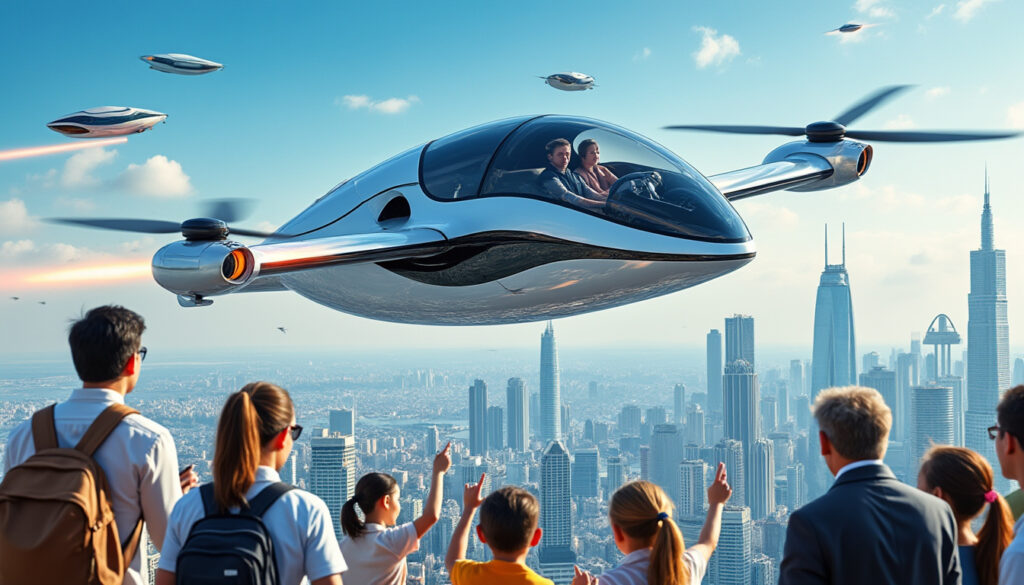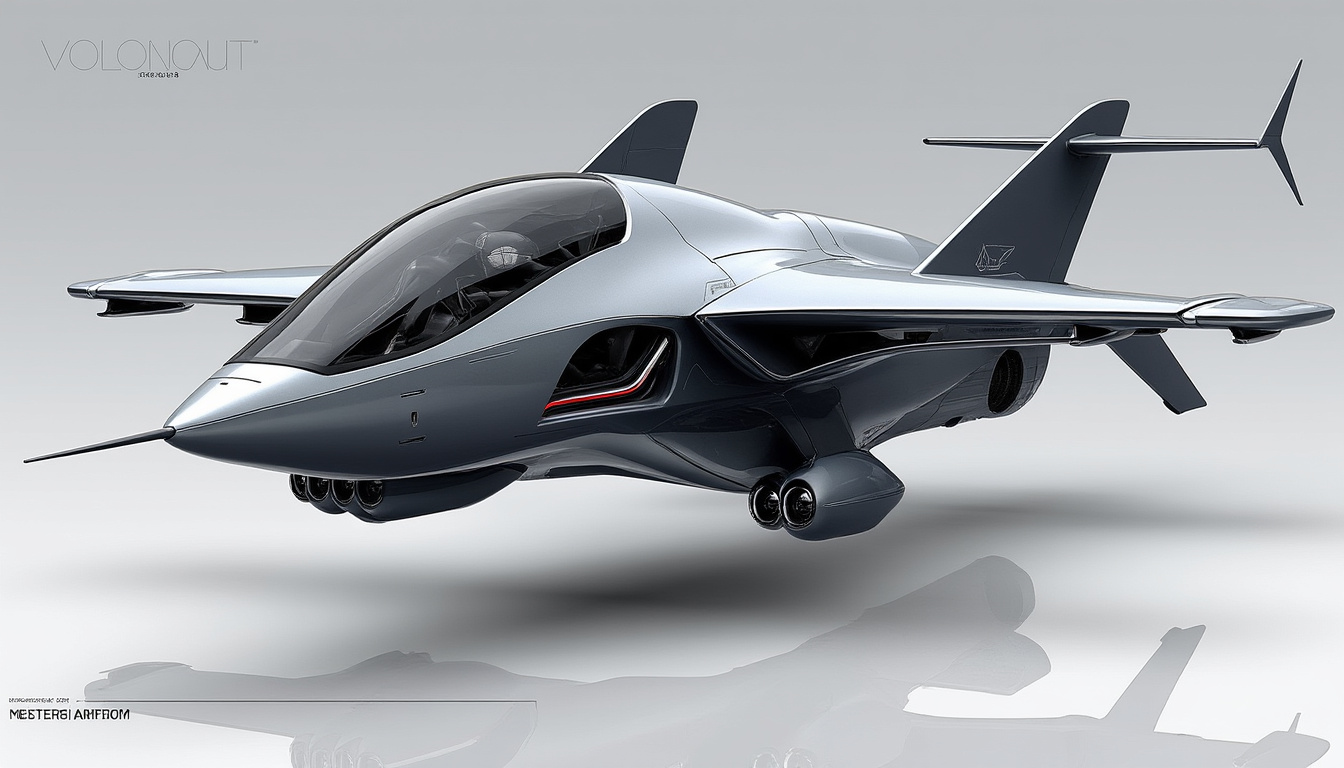Volonaut Airbike: an innovative flying motorcycle with lingering questions

In a constantly evolving world, where technological innovation seems to travel at the speed of light, the Volonaut Airbike represents a bold step towards the future of transportation. Unveiled on May 1, 2025, by Polish inventor Tomasz Patan, this vertical takeoff vehicle is presented as the answer to our urban mobility challenges. Favoring a design that is both futuristic and minimalist, this prototype raises fascinating questions about its integration into our daily lives and the regulation of airspace.
Summary
- 1. The unique design of the Airbike
- 2. A new era of air mobility
- 3. Technical and environmental challenges
- 4. Regulation and access to air mobility
- 5. The future of flying motorcycles
The unique design of the Airbike
The Volonaut Airbike demonstrates an innovative vision of personal transport. Its lightness is one of its primary assets. Indeed, this flying motorcycle is made from carbon fiber materials, allowing it to be seven times lighter than a traditional motorcycle. The integration of 3D printing technology in its manufacturing enables a reduction in production costs and an optimal arrangement of components.
One of the striking elements of the Airbike's design is its lack of wheels and wings, a radical change that transforms our perception of the motorcycle. With concealed rotors, this vehicle manages to combine aesthetics and functionality. Its ability to reach a maximum speed of 200 km/h, coupled with a range of 40 km, makes it an innovative transportation solution, particularly suited to dense urban environments.
Integrated advanced technology
Besides its design, the Airbike is equipped with a multitude of safety and assistance systems. Its LIDAR system allows it to avoid obstacles in real time, while geofencing ensures compliance with sensitive airspaces. This raises a crucial point: how can we guarantee the safety of users as well as that of airspace? This is where the heart of this innovation lies.
- Lightweight materials and minimalist structure
- Advanced propulsion technology
- Integrated safety systems
| Feature | Details |
|---|---|
| Weight | Seven times lighter than a classic motorcycle |
| Maximum speed | 200 km/h |
| Range | 40 km |
| Recharge time | Less than 2 hours |

A new era of air mobility
The launch of the Volonaut Airbike marks the beginning of an era where air mobility becomes a daily reality. Imagine a future where traffic jams are a thing of the past. Picture being able to fly over the city to get to your workplace, avoiding congested roads. This vision, once solely associated with science fiction, could soon become a common aspect of our lifestyle.
With the rise of vehicles like the Airbike, the concept of transportation of the future calls to us. Realizing smoother and faster urban journeys through the ability to take off vertically from a roof or courtyard could transform our daily lives. This change might encourage metropolises to rethink their urban planning, integrating infrastructures suitable for these new modes of transport.
International examples
Countries like the United Arab Emirates and the United States are already experimenting with similar solutions. Flying taxi projects are emerging, emphasizing the need for regulatory support. Governments are now pushed to devise laws to regulate air traffic, thereby making air mobility accessible to the general public. This also raises questions about the ecological impact of these new devices.
- Improvement of urban transit
- Encouragement of sustainable development
- Proposals for suitable infrastructures
| Country | Initiatives |
|---|---|
| United States | Flying taxis in testing phase |
| United Arab Emirates | Plans for the integration of aerial vehicles |
| Japan | Development of eVTOL for urban travel |
Technical and environmental challenges
Despite its promising potential, the Volonaut Airbike faces significant technical and environmental challenges. The question of the energy efficiency of these devices is crucial. Although the Airbike is designed to be powered by renewable energy sources, it remains to be proven that its operation is truly sustainable on a large scale.
On the other hand, the noise impact of flight is also worth considering. Aerial vehicles represent a real source of nuisance in urban areas. The search for solutions to minimize the noise generated by takeoffs and landings could thus become a major challenge for the acceptance of these modes of transport.
Possibilities for improvement
Experts suggest several lines of thought regarding these challenges. The implementation of strict environmental standards for aerial vehicles could help steer development towards more sustainable solutions. Similarly, investments in research could give rise to quieter propulsion technologies, making the flying experience more pleasant.
- Research and development on energy efficiency
- Environmental standards for aerial vehicles
- Innovations to reduce noise
| Challenge | Potential solutions |
|---|---|
| Energy efficiency | Investment in renewable energy |
| Noise | Research on silent propulsion systems |
Regulation and access to air mobility
One of the most complex aspects of the Volonaut Airbike lies in the regulation of airspace. Currently, only a few countries have begun to adjust their laws to integrate these new means of transport. The debate is thus underway in Europe, where regulation proposals are varied.
However, it is crucial to define clear rules on who can fly, where, and under what conditions. For future users, this could translate into the necessity of obtaining a pilot's certificate, although options for autonomous piloting are also being presented, allowing to lower entry barriers for novices.
Examples of regulatory development
Aviation regulations, already rigorous, have continued to evolve in response to these challenges. Certain countries like the United States have implemented pilot projects allowing low-altitude flights in urban areas, while other nations are adapting their laws to facilitate rapid integration.
- Pilot certification required to fly
- Regulations for flying over sensitive areas
- Facilitated access through autonomous piloting
| Country | Regulations |
|---|---|
| United States | Experiments for urban flights |
| Europe | Ongoing adaptation of regulations |
The future of flying motorcycles
Through the innovations brought by the Volonaut Airbike, we are witnessing a redefinition of the concept of personal transport. This vehicle is not simply limited to being a flying motorcycle; it embodies a futuristic vision of how we move. While the Airbike is currently a prototype, commercial versions could emerge as early as 2026, marking a major turning point in how we travel.
Ultimately, this vehicle could change the face of urban planning. Cities, in order to adapt to these new vehicles, will need to rethink their infrastructures and integrate suitable takeoff and landing zones. An exciting prospect for a future where ecology and innovation intersect to form a new paradigm of air mobility.
Challenges for the future
By 2026, it will not only be a question of technology but also of collective responsibility for the development of a sustainable air mobility network. The ability of governments and companies to work together will be crucial in making this innovation a reality that is accessible and seamlessly integrated into our lives.
- Reinventing cities around air mobility
- Innovative opportunities for entrepreneurs
- Intergovernmental collaboration for regulation
Source: www.caradisiac.com
Leave a Reply



Articles relatifs